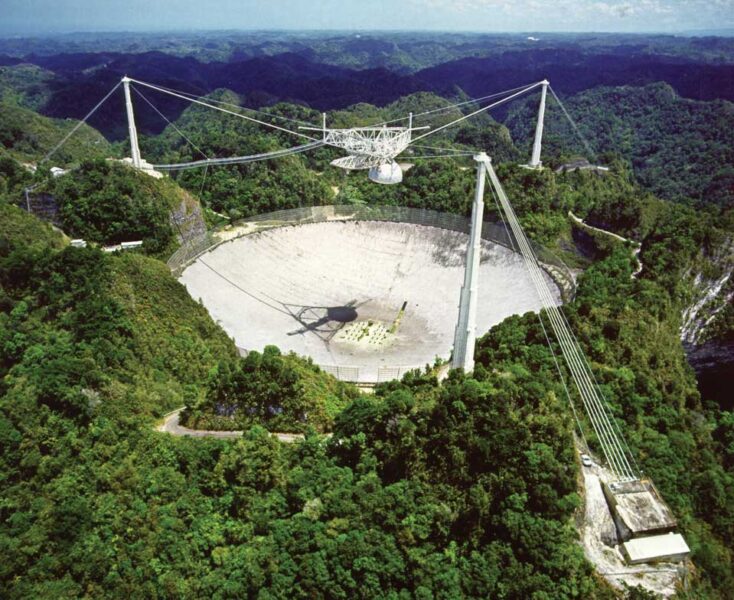On the painful loss of an iconic Space Age observatory.

Arecibo Observatory / NSF
Even as a kid I knew of a place called Arecibo, a mysterious facility in the jungle where astronomers peered into outer space and searched for alien transmissions. When I could understand basic geometrical concepts, I learned how a giant parabolic dish built into a sinkhole could gather and concentrate diffuse radiation from distant sources that would otherwise have fallen unseen in the surrounding rainforest, focusing it to a point where its power was sufficient to reveal the previously unseeable.
In the 1960s and ’70s, as interplanetary craft were first setting out for our neighboring worlds, this magnificent instrument in northwestern Puerto Rico was also extending our human senses to heretofore hidden places and wavelengths. In magazine pictures, its perfect, curving dish and monumental support structure seemed like a futuristic synthetic eye of outrageous proportions. With it, we could seek answers for our nagging curiosity and antidotes to our cosmic loneliness.
As a young space geek, I learned that scientists had used Arecibo to determine the rotation rate of Mercury, discover the tallest mountain range on cloud-shrouded Venus, and, beyond our solar system, reveal neutron stars, binary pulsars, and other astrophysical marvels. I grew up on stories of Frank Drake, Carl Sagan, and Jill Tarter listening for alien signals there and sending out a few symbolic messages of their own. I admired Arecibo’s role as planetary defense sentinel, identifying and tracking Earth-crossing asteroids.
In short, for me as for so many others, Arecibo was iconic long before Hollywood filmmakers used it as a dramatic backdrop in Contact and GoldenEye.
Later in life, I made a pilgrimage there. I walked those vertiginous catwalks out to the receiver suspended 450 feet above the dish by 18 cables running from three giant towers. When I visited, in 2012, it wasn’t shiny and new. The dish’s surface looked a bit moldy, some of the hardware seemed a little rusty, and the surrounding jungle appeared ready to swallow the whole place up. The control rooms, with their huge transformers and racks of computer equipment, looked very mid-20th century, like something, well, out of a James Bond movie.
Yet scientists were still doing cutting-edge science there, and I shared the dismay of so many when I learned on December 1st that our beloved mystery portal, in desperate need of repairs and already teetering dangerously from two recently broken support cables, had suffered an irreparable collapse.
Similar work will continue at other large radio dishes on Earth, but what we really want to know is if others exist elsewhere in the galaxy. Would minds evolving out there have converged on the same idea, to parabolically gather waves so that they may interrogate our shared galaxy and perhaps come to know us?
My whole life I’ve tried to picture those alien Arecibos and wondered if — like that transporter machine in Contact — ours might be an aperture across the galaxy to theirs. Now I wonder what will happen to Arecibo. Will the jungle reclaim it? Will it one day be an archeological site where visitors (Earthlings or otherwise) will marvel that there was once a civilization that valued science and exploration enough to build such a wonder but not quite enough to keep it going for more than two Saturn years?
This article originally appeared in print in the March 2021 issue of Sky & Telescope. Subscribe to Sky & Telescope.
 0
0
Comments
You must be logged in to post a comment.